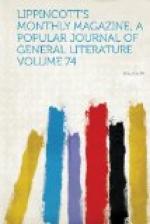Although a long succession of naturalists have done their best to familiarize readers with the islands of the Eastern Archipelago, Mr. Forbes’s book is full not only of freshly-adjusted and classified facts, but of curious and valuable details of his own discoveries. Even the best-known islands of the group are so inexhaustible in every form of animal and vegetable life that much remains for the patient gleaner after Darwin and Wallace, who found here some of the most striking illustrations of their deductions and theories, It is well known that startling contrasts in the distribution of plants and animals are met with in these islands, even when they lie side by side; and in no other part of the world is the history of mutations of climate, of the law of migrations, and of the changes of sea and land, so open and palpable to the scientific observer. Mr. Forbes’s object seems to have been to visit those islands which offer the most striking deviations from the more general type. His earlier explorations were made alone, but during the last eighteen months he was accompanied by a brave woman who came out from England to Batavia to be married to him at the close of 1881. It is painful to read of the deadly ordeals of climate and the excessive discomforts and privations to which this lady was exposed. Her diary, kept at Dilly during her husband’s absence, while she was ill, utterly deserted, and in danger of a lonely and agonizing death, makes a singular contrast to the record of Miss Bird and others of her sex who seem to have triumphed over all the vicissitudes possible to women. To the general reader Mr. Forbes’s travels in Java, Sumatra, and the Keeling Islands are far more satisfactory than in those less familiar, like Timor and Buru. In the light of the terrible events of 1883, everything connected with the islands lying on either side of the Straits of Sunda is of the highest interest. Those appalling disasters which swept away part of Sumatra and Java and altered the configuration of the whole volcanic group surrounding Krakatoa took place only a few weeks after Mr. and Mrs. Forbes sailed for home. This widespread destruction seemed to the inhabitants the culmination of a series of calamitous years of drought, wet, blight, bovine pestilence, and fever. It was Mr. Forbes’s fortune to be in Java during these bad seasons, which, from combined causes, made it impossible for flowers to perfect themselves and fructify. This circumstance was, however, useful to the naturalist, offering him an opportunity for experiments in the fertilization of orchids and other plants. The account of the Dutch cinchona-plantations, which now furnish quinine of the best quality, is full of interest.




